International Journal of Computer Network and Information Security @ijcnis
Статьи журнала - International Journal of Computer Network and Information Security
Все статьи: 1177
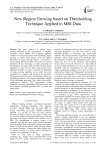
New Region Growing based on Thresholding Technique Applied to MRI Data
Статья научная
This paper proposes an optimal region growing threshold for the segmentation of magnetic resonance images (MRIs). The proposed algorithm combines local search procedure with thresholding region growing to achieve better generic seeds and optimal thresholds for region growing method. A procedure is used to detect the best possible seeds from a set of data distributed all over the image as a high accumulator of the histogram. The output seeds are fed to the local search algorithm to extract the best seeds around initial seeds. Optimal thresholds are used to overcome the limitations of region growing algorithm and to select the pixels sequentially in a random walk starting at the seed point. The proposed algorithm works automatically without any predefined parameters. The proposed algorithm is applied to the challenging application "gray matter/white matter" segmentation datasets. The experimental results compared with other segmentation techniques show that the proposed algorithm produces more accurate and stable results.
Бесплатно
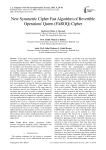
New Symmetric Cipher Fast Algorithm of Revertible Operations' Queen (FAROQ) Cipher
Статья научная
In this paper, we have proposed a new iterated symmetric cipher, which is designed with Substitution and Permutation Network (SPN) structure and depends on strong mathematical built. It uses a compact algorithm for encryption and decryption processes, which consists of four main stages that roughly similar in its work to the Advance Encryption Standard (AES) stages. Starting by the SubByte operation, ReversibleShiftrows operation, ReversibleMixcolumns operation, and Round key addition. The proposed operations in this cipher have implemented in a straightforward manner relatively in both Encryption/Decryption by an elegant way. These four stages designed to reduce the hardware requirements and to produces high efficiency, which keeps the encryption and decryption process at the same speed in the hardware devices and eliminates the difference of execution times as well as creates a balance in forward and backward operations. The proposed cipher interested with modern design by adopted new algebraic operations and clear mathematical notations to ensure a high level of security. The proposed cipher did not build suddenly or arbitrarily but it acts as a sequence of developments and represents as a long process of design for long time, since several proposed ciphers have been published recently by us that paved the way to its new design, so the designed cipher inherited a good properties from a proven famous algorithms' features to produce high resistance against all known attacks and to submit a high performance on many platforms and in a wide range of hardware and software applications.
Бесплатно
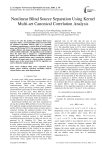
Nonlinear Blind Source Separation Using Kernel Multi-set Canonical Correlation Analysis
Статья научная
To solve the problem of nonlinear blind source separation (BSS), a novel algorithm based on kernel multi-set canonical correlation analysis (MCCA) is presented. Combining complementary research fields of kernel feature spaces and BSS using MCCA, the proposed approach yields a highly efficient and elegant algorithm for nonlinear BSS with invertible nonlinearity. The algorithm works as follows: First, the input data is mapped to a high-dimensional feature space and perform dimension reduction to extract the effective reduced feature space, translate the nonlinear problem in the input space to a linear problem in reduced feature space. In the second step, the MCCA algorithm was used to obtain the original signals.
Бесплатно
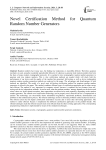
Novel Certification Method for Quantum Random Number Generators
Статья научная
Random numbers have many uses, but finding true randomness is incredibly difficult. Therefore, quantum mechanics is used, using the essentially unpredictable behavior of a photon, to generate truly random numbers that form the basis of many modern cryptographic protocols. It is essential to trust cryptographic random number generators to generate only true random numbers. This is why certification methods are needed which will check both the performance of our device and the quality of the random bits generated. Self-testing as well as device independent quantum random number generation methods are analyzed in the paper. The advantages and disadvantages of both methods are identified. The model of a novel semi self-testing certification method for quantum random number generators is offered in the paper. This method combines different types of certification approaches and is rather secure and efficient. The method is very important for computer science, because it combines the best features from self-testing and device independent methods. It can be used, when the random numbers’ entropy depends on the device and when it does not. In the related researches, these approaches are offered to be used separately, depending on the random number generator. The offered novel certification technology can be properly used, when the device is compromised or spoiled. The technology can successfully detect unintended irregularities, operational problems, abnormalities and problems in the randomization process. The offered mythology assists to eliminate problems related to physical devices. The offered system has the higher certification randomness security and is faster than self-testing approaches. The method is rather efficient because it implements the different certification approaches in the parallel threads. The offered techniques make the offered research must more efficient than the other existing approaches. The corresponding programming simulation is implemented by means of the simulation techniques.
Бесплатно
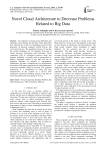
Novel Cloud Architecture to Decrease Problems Related to Big Data
Статья научная
IT companies are facing many difficulties and challenges when dealing with big data. These difficulties have surfaced due to the ever-expanding amount of data generated via personal computer, mobile devices, and social network sites. The significant increase in big data has created challenges for IT companies that need to extract necessary information and knowledge. Cloud computing, with its virtualized resources usage and dynamic scalability, is broadly used in organizations to address challenges related to big data and has an important influence on business in organizations. Furthermore, big data is changing the way organizations do business. This paper proposes novel cloud architecture to decrease problems related to big data. The proposed architecture is a combination of many big data infrastructures in the creation of a service. This architecture minimizes problems related to big data by improving performance and quality of service.
Бесплатно
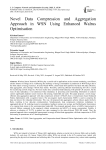
Novel Data Compression and Aggregation Approach in WSN Using Enhanced Walrus Optimisation
Статья научная
Wireless Sensor Networks (WSNs) play a crucial role in applications such as remote monitoring, surveillance, and the Internet of Things (IoT). Addressing the challenge of energy consumption is paramount in WSN design due to the finite nature of energy resources. In cluster-based WSNs, cluster heads (CH) perform vital tasks like data collection, data aggregation, and exchange with the base station. Therefore, achieving efficient load balancing for CHs is crucial for maximizing network longevity. Previous studies have considered load balancing with optimal CH selection, but the issue of data redundancy is not addressed. Data redundancy in processing and transmitting information to analysis centres significantly depletes sensor resources like (energy, bandwidth and such). This paper proposes a novel energy-efficient data aggregation approach with data compression termed C-EWaOA that is (Compression based Enhanced Walrus Optimization with a cognitive factor). The non-negative matrix factorization (NMF) is used to compress the data and remove the redundant information. This way, the proposed data aggregation scheme reduces packet delivery Ratio, resulting in low data-rate communication. Simultaneously, data compression minimizes redundancy in aggregated data at CH, reducing resource consumption, leading to energy cost savings, and facilitating the transmission of a compact data stream in the communication bandwidth. The proposed approach shows a 0.606% improvement in network lifetime compared to the approach without compression and 68.01% of energy consumption. Notably, it achieves a reduction of 78.57% in packet loss ratio compared to the state-of-the-art FEEC-IIR model. Thus, the proposed approach shows remarkable improvement in energy-efficient data aggregation with data compression in WSN showcasing its prominence in IoT-based applications.
Бесплатно
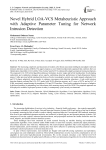
Статья научная
The increasing complexity and dynamism of modern cyber threats necessitate intelligent and adaptive network intrusion detection systems (NIDS). This paper proposes a novel hybrid metaheuristic approach that combines the Lion Optimization Algorithm (LOA) with the Virus Colony Search (VCS), enhanced by adaptive parameter tuning mechanisms. The proposed LOA-VCS hybrid algorithm addresses limitations in prior single and hybrid metaheuristic by alternating exploration and exploitation strategies across epochs, optimizing detection performance in high-dimensional feature spaces. Unlike previous hybrid metaheuristics that use fixed or non-adaptive control, our model uniquely alternates LOA and VCS phases adaptively across epochs to enhance convergence and detection robustness. A real-world intrusion detection dataset evaluated the LOA-VCS model with 98.4% detection accuracy, an F1-score of 0.976, and an AUC of 0.986, consistently outperforming the standalone LOA and VCS baselines. These results emphasize the power of adaptive hybrid met heuristics in maintaining low false alarms while ensuring strong recall for NIDS. The proposed approach can be deployed in scalable, high-speed systems in today’s contemporary cyber security environments.
Бесплатно
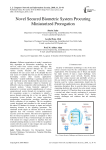
Novel secured biometric system procuring miniaturized prorogation
Статья научная
Different organizations in today’s scenario are fully dependent on information technology for their survival, suffer from various security challenges like unauthorized access, physical damages etc. To avoid various security breaches and concerns, robust mechanism for user access need to be adopted that not only secure of valuable data but can also be utilized for developing various other security applications. “Biometric” secured technology is gaining attention for over traditional security mechanism like password, smart card etc. because information related to biometric are difficult to steal as compared to other mechanisms. In this research analysis “strong biometric approach” is proposed to overcome security apprehensions of various organizations& society through iris recognition system. Iris recognition system is a mechanism to identify a person through analyzing his or her iris pattern. This recognition system includes iris image acquisition, segmentation, normalization, encoding, matching and finally validation of iris templates. The iris recognition system developed and simulated in this research study has taken IIT database iris images as inputs and utilized hamming distance as the matching parameter. The simulated results depict an efficient and novel secured approach that will overcome various unauthorized accesses across the internet. The most novel approach of this iris based recognition system as compared to other traditional systems is that, if selected images are matched with trained iris images present in database then the resultant hamming distance as most of the iris recognition systems directly accept or reject images and causes huge congestion and execution prorogations.
Бесплатно
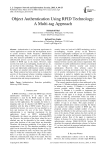
Object Authentication Using RFID Technology: A Multi-tag Approach
Статья научная
Authentication is an important requirement in various applications to restrict the non-legitimate access to certain resources. Radio Frequency Identification (RFID) technology helps to perform the authentication task. The detection probability of an object during the authentication process can be increased using multiple number of RFID tags in the object. However, many security risks such as eavesdropping, location privacy etc. are involved in this technology. This paper proposes a secure and lightweight authentication scheme assuming the objects are attached with multiple number of RFID tags. Proper analysis has been carried out to evaluate the security of the proposed scheme, including comparison with a few existing schemes in terms of computation, communication and storage requirements.
Бесплатно
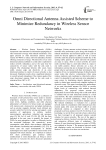
Omni Directional Antenna Assisted Scheme to Minimize Redundancy in Wireless Sensor Networks
Статья научная
Wireless Sensor Networks (WSNs) incorporate smart antennas for information propagation to offer connected coverage with reduced interference. This paper presents an omni directional antenna assisted scheme for WSNs to reduce network redundancy besides offering connected coverage. The directivity of an omni directional antenna outfitted on a sink node is exploited to reduce network redundancy and at the same time the connectivity of sensor nodes with the sink node is retained. The relationship between lobe count, beam width, rotation angle and directivity of an omni directional antenna in context of sensor networks is also discussed. Simulation results show a significant reduction in overall network redundancy if the rotation angle of the omni directional antenna fitted on the sink node is minimized from 360° to 30°
Бесплатно

On Classical Cryptographic Protocols in Post-Quantum World
Статья научная
In post-quantum approach, we consider classical (non-quantum) protocols and primitives which are run by honest parties on classical computers and our aim is to keep their security in an environment where the adversary can rely on quantum computers [3]. In particular, even a harder goal is set by requiring provable security guaranties in a concurrent running environment as we aim computational UC-security. Unruh [16] conjectured that classical arguments of computational UC-security remain usable in a post-quantum world as long as the underlying computational UC-secure primitives are also computationally quantum UC-secure. Our proposed technique (full factorization) aims at reducing the original protocol into a statistically-secure protocol by turning the protocol into a hybrid one where all cryptographic primitives are substituted by appropriate ideal functionalities. The considered set of primitives consists of secret key and public key encryption as well as digital signature. This way and by applying the Unruh's Quantum Lifting Theorem as well as the Quantum Universal Composition Theorem we gain a computationally quantum UC-secure protocol from a classical UC-secure protocol. We consider quantum standard-security, where the adversary can send only classical inputs to honest algorithms, i.e. honest machines cannot receive quantum superposition of inputs If we add also the practical need of efficiency our example is the class of protocols built from symmetric key primitives. A practical (fast) implementation could be based on AES encryption algorithm with appropriate key size as long as we live with the wide belief that this algorithm is secure against a quantum adversary.
Бесплатно
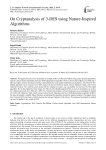
On Cryptanalysis of 3-DES using Nature-Inspired Algorithms
Статья научная
This paper presents a novel cryptanalysis method of DES (2-DES and 3-DES) using nature-inspired algorithms; namely Cuckoo Search Algorithm and Grey Wolf Optimization Algorithm. We have shown the loophole of 2-DES and 3-DES encryption systems and discovered the vulnerabilities by some simple mathematical calculations. The Meet-In-The-Middle approach can be executed on 2-DES along with Known Plaintext Attack, Chosen Plaintext Attack, and Chosen Ciphertext Attack. The valid key pairs along with the original key pairs can successfully be recovered by this attack algorithm. But in the Ciphertext Only Attack, the Meet-In-The-Middle approach fails to recover the plaintext as well as the valid key pairs both for 2-DES and 3-DES. To overcome this problem, we have proposed a novel cryptanalysis method of 3-DES with Ciphertext Only Attack using Cuckoo Search Algorithm and Grey Wolf Optimization Algorithm (GWO). We have developed a suitable fitness function, accelerating the algorithm toward the optimal solution. This paper shows how CSA and GWO can break a 3-DES cryptosystem using a Ciphertext Only Attack. This proposed cryptanalysis method can also be applied to any round of DES.
Бесплатно
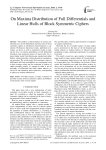
On Maxima Distribution of Full Differentials and Linear Hulls of Block Symmetric Ciphers
Статья научная
The problem of determination of maxima dis-tribution laws of full differentials and linear bias of block symmetric ciphers as substitution transformations is con-sidered. Well-known theoretical results, published in lit-erature, are given, as well as experiment results on mak-ing the laws of maxima distribution of full differential transitions and maximum biasess of linear hulls for re-duced cipher model from Belorussian standard and cipher Kalina, which practically confirm theoretical calculations, are presented. The results testify that maximum values of differential and linear probabilities are concentrated close to their average values and for evaluation of indexes of cipher provable security it's enough to make a test of proximity of differential and linear cipher indexes, re-ceived for one arbitrarily taken cipher key corresponding to indexes of random substitutions.
Бесплатно
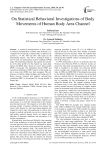
On Statistical Behavioral Investigations of Body Movements of Human Body Area Channel
Статья научная
A statistical characterization of body surface to external communication of Body Area Network is investigated for movement of human body in different directions i.e. 00, 900, 1800 and 2700, with respect to the transmitting antenna. The NICT's statistical model is used to carry out measurement in ultra-wideband (UWB) range. The important parameters that capture the variability of the delay profile over the channel e.g. mean delay spread and RMS delay spread of power delay profile (PDP) is presented. The probability density (PDF) and cumulative distribution (CDF) function of the output signal to noise ratio (SNR) have been computed. The performance of Selective Rake (S-Rake) and Partial rake (P-Rake) receiver structure that employs maximal-ratio combining (MRC) is investigated for varying number of fingers taps.
Бесплатно
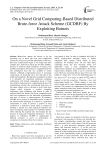
On a Novel Grid Computing-Based Distributed Brute-force Attack Scheme (GCDBF) By Exploiting Botnets
Статья научная
Brute-force attacks are known to be the promising way to break into even most complicated systems by trying every possible permutation of the keys. But since cryptosystems began to use longer and more complex keys, brute-force attacks has lost their usability, because of relatively high complexity of trying every possible permutation with respect to computational power and computation time that was available to crypto breakers. Although computational power is increasing continuously, its increasing rate is less than that of key length and complexity. Having these assumptions in mind, it is infeasible for centralized traditional computing architectures with limited computation power to break into modern cryptosystem by compromising the key with implementing schemes like conventional brute-force. In this paper authors aim for devising a novel brute-force scheme which integrates a modern computing architecture (grid computing) with botnets in order to perform brute-force attacks with lower computation time and lower equipment cost for individual cryptobreakers who have no access to supercomputers. In summary, GCDBF uses a portion of computation power of each of the infected nodes belonging to a botnet in a grid-based environment in order to process a portion of total workload of a brute-force attack which is needed for breaking a specific key. This approach neutralizes the need of acquiring supercomputers for individual hackers while reducing the required time for breaking the key because of using grid computing architecture. For the purpose of evaluation, GCDBF is implemented in different scenarios to prove its performance in comparison to centralized brute-force scheme.
Бесплатно
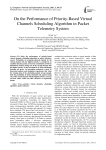
Статья научная
We Study the performance of priority–based virtual channels scheduling algorithm in packet telemetry system. Probability of occupying physical channel by the virtual channel with the highest priority is considered, on condition that the packet arrival rate contribution is Poisson distribution. Packets losing rate of the virtual channel with the highest priority is also investigated, of which calculating formulas are given. An interesting conclusion is made by theoretical analysis and simulation experiments that when the running time of the scheduling module is long enough, both the probability of being scheduled and packets losing rate of the virtual channel with the highest priority converge on fixed values, which can offer reference to engineering design.
Бесплатно
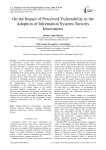
On the impact of perceived vulnerability in the adoption of information systems security innovations
Статья научная
A number of determinants predict the adoption of Information Systems (IS) security innovations. Amongst, perceived vulnerability of IS security threats has been examined in a number of past explorations. In this research, we examined the processes pursued in analysing the relationship between perceived vulnerability of IS security threats and the adoption of IS security innovations. The study uses Systematic Literature Review (SLR) method to evaluate the practice involved in examining perceived vulnerability on IS security innovation adoption. The SLR findings revealed the appropriateness of the existing empirical investigations of the relationship between perceived vulnerability of IS security threats on IS security innovation adoption. Furthermore, the SLR results confirmed that individuals who perceives vulnerable to an IS security threat are more likely to engage in the adoption an IS security innovation. In addition, the study validates the past studies on the relationship between perceived vulnerability and IS security innovation adoption.
Бесплатно
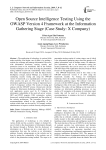
Статья научная
The application of technology in various fields makes mobility even higher, one of them is by making a website for exchange and manage information. However, with information disclosure causing security and protection issues to be considered. One of the website security techniques can be done by using the penetration testing method to know the vulnerability of the system. This study will implement tools with the Open Source Intelligence concept, namely Maltego as a medium for conducting security testing and using the OWASP version 4 framework as a standardization of steps taken when security test goes on. This study will focus on information gathering security testing of important factor of the X Company's website. The results of testing and analysis with the OWASP version 4 framework with the Testing for Information Gathering module show that the web application system used by X Company has information vulnerability of the used web server version, GET and POST requests, URL systematics, website framework, website builder component, and the outline of the website architecture. The researcher gave several recommendations related to the vulnerability of the website which later can be used by X Company website administrators to improve website security and protection.
Бесплатно
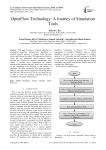
OpenFlow Technology: A Journey of Simulation Tools
Статья научная
This paper presents a complete guideline for developing OpenFlow infrastructure. OpenFlow is standard network protocol to manage traffic between routers and Ethernet Switches. This approach will help to create the next generation virtual network, which provides the solution for network management, flow control of packets, delay optimization etc without interfering the backbone network. Here a brief idea about all the supporting tools involved in the journey of OpenFlow has been introduced. This paper provides a solution with top to bottom approach to install OpenFlow network tools. On the basis of one by one approach user is able to solve the problem appeared during the installation with proper justifications.
Бесплатно
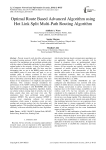
Optimal Route Based Advanced Algorithm using Hot Link Split Multi-Path Routing Algorithm
Статья научная
Present research work describes advancement in standard routing protocol AODV for mobile ad-hoc networks. Our mechanism sets up multiple optimal paths with the criteria of bandwidth and delay to store multiple optimal paths in the network. At time of link failure, it will switch to next available path. We have used the information that we get in the RREQ packet and also send RREP packet to more than one path, to set up multiple paths, It reduces overhead of local route discovery at the time of link failure and because of this End to End Delay and Drop Ratio decreases. The main feature of our mechanism is its simplicity and improved efficiency. This evaluates through simulations the performance of the AODV routing protocol including our scheme and we compare it with HLSMPRA (Hot Link Split Multi-Path Routing Algorithm) Algorithm. Indeed, our scheme reduces routing load of network, end to end delay, packet drop ratio, and route error sent. The simulations have been performed using network simulator OPNET. The network simulator OPNET is discrete event simulation software for network simulations which means it simulates events not only sending and receiving packets but also forwarding and dropping packets. This modified algorithm has improved efficiency, with more reliability than Previous Algorithm.
Бесплатно

